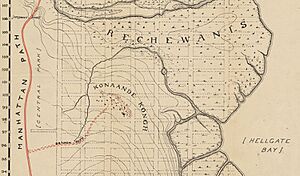Konaande Kongh facts for kids

Konaande Kongh was a village where the Lenape people lived a long time ago. It was located near what is now 98th Street and Park Avenue in East Harlem, New York City. This village was built on a high piece of land. A path connected it to the main trail of Manhattan island.
People lived in Konaande Kongh until 1669. That's when the land became part of the growing Dutch colony called New Netherland. Konaande Kongh has been described as a major village, a smaller settlement, and even a temporary camp.
Contents
What Does the Name Mean?
The name Konaande Kongh comes from the Lenape language. It means "the hill near which they fish with nets." This name refers to a popular fishing spot. Today, that area is known as Hell Gate, a narrow waterway in New York City.
A Look Back: The History of Konaande Kongh
Life at Konaande Kongh
Konaande Kongh was a popular place for the Lenape people to live. They could easily hunt and fish nearby. In the mid-1600s, the main leader of this area was Chief Rechewack. The people living there were called the Reckgawawanc.
The Reckgawawanc sometimes faced attacks from the Mohawk who lived north of their land. However, a historian named James Riker noted something important. Even though there were wars, they were usually about people or their belongings. The wars did not usually mean the Lenape lost their land. So, their right to the land often stayed strong.
At the same time, Dutch settlements were growing. These settlements, part of New Netherland, were moving north from the southern part of Manhattan island. The Dutch wanted to own more land, including the area where Konaande Kongh was. Other Lenape villages nearby had already been left behind. For example, Sapohanikan was abandoned in the 1630s. Another place, Nechtanc, was the site of a terrible event in 1643. The Dutch had also gained control of land in northern Manhattan by 1647.
When the Land Changed Hands
In 1669, the land where Konaande Kongh stood was officially transferred. It went to Jean Mousnier de la Montagne. He was an important political leader in the Dutch colony. This colony now included the area that is Central Park today. It stretched from Hell Gate to the Harlem River. Chief Rechewack had held onto the land until then, despite pressure from the Dutch.
When the land was transferred, Konaande Kongh was mentioned. It was described as a place near "the Point named Rechwanis."
In 1675, the Dutch told the Lenape people to move. They were ordered to go to their usual winter homes near Hellgate on Manhattan island. This shows that the Lenape people were still using nearby areas. They likely used them for hunting.

